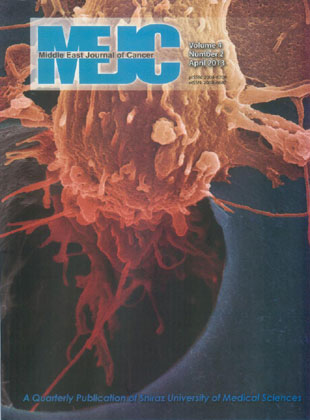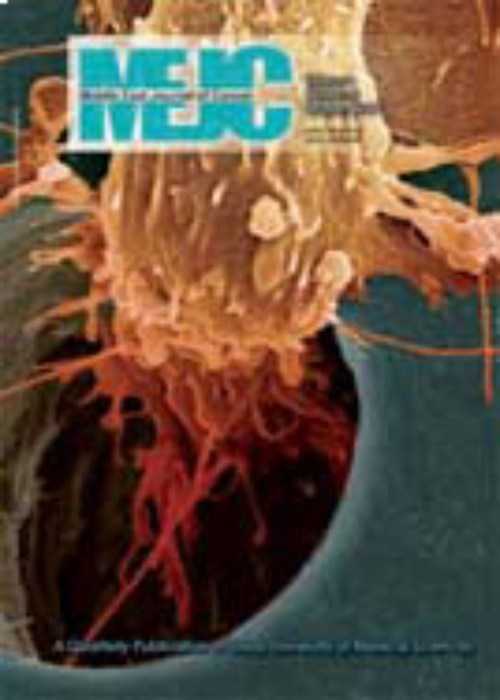فهرست مطالب

Middle East Journal of Cancer
Volume:4 Issue: 2, Apr 2013
- تاریخ انتشار: 1392/03/01
- تعداد عناوین: 7
-
-
Page 45BackgroundCancer diagnosis has a significant impact not only on women, but also on their Primary caregivers. Understanding the effects of a breast cancer diagnosis on physical and mental health outcomes in caregivers is important because these variables are key components of quality of life. Quality of life is a multi-dimensional construct measuring overall enjoyment of life. This study intends to describe the impact of caring for women with breast cancer on the quality of life among their primary caregivers.MethodWe conducted a comprehensive search in PubMed, MEDLINE and CINAHL. In addition, we used the web search engine “Google” for abstracts from 2007 to 2012. A total of eight studies were reviewed that met the following inclusion criteria: adult women with breast cancer, research conducted in English. Studies ranged from 2007-2011. The total sample size in the eight studies on adult caregivers totaled 789 participants. The average age of participants in all of the studies was 49.55 years.There were seven studies that had a quantitative focus,which mainly used a questionnaire and survey to estimate quality of life among primary caregivers. The qualitative approach included in-depth interviews and a focus group.ResultsAccumulating evidence has supported the concept that cancer affects not only the patients but also their primary caregiver's quality of life.They face multiple challenges in caring for women with breast cancer, including physical, emotional, social, and financial stress that affects the caregiver's quality of life.ConclusionBreast cancer diagnosis not only affects the patient's quality of life, but in parallel, also affects the quality of life of the primary caregiver. Thus more focus should be placed on providing moral and social support, and educational resources to improve the level of the caretaker's quality of life.Keywords: Family caregiver, Caregiver burden, Breast cancer, Literature review
-
Page 51BackgroundBiomarkers accepted for clinical use in breast cancer have low sensitivity and specificity. Thus, there is a need for new markers to assist in the diagnosis, prognosis and follow-up of breast cancer patients. This study aims to investigate the diagnostic, prognostic and follow-up role of serum Bcl-2, Bax and p53 proteins in breast cancer patients in comparison with those of serum CA 15-3 as the most commonly used breast cancer marker.MethodsWe analyzed 50 breast cancer patients (before surgery, after one month of surgery and after six cycles of chemotherapy) and 50 normal healthy controls for serum Bcl-2, Bax, p53 and CA 15-3 levels.ResultsMean serum Bcl-2 and CA 15-3 levels significantly increased, whereas the mean serum p53 level significantly declined in breast cancer patients compared to normal healthy controls. Using the ROC curve analysis, serum p53 had the greatest area under the curve (85.6%). Serum Bcl-2 levels significantly decreased after six cycles of chemotherapy compared with its level one month after surgery. Preoperative serum levels of Bcl-2, Bax, p53 and CA 15-3 were non-significantly correlated with patient's disease-free survival.ConclusionSerum p53 was superior to Bcl-2 and CA 15-3 in the diagnosis of breast cancer patients. Only Bcl-2 could be used for monitoring the effect of chemotherapy on breast cancer patients. None of the assayed biomarkers had a role in monitoring the effect of surgery on breast cancer patients. None of the assayed biomarkers had a prognostic role for breast cancer patients.Keywords: Breast cancer, Apoptosis, Bcl, 2, Bax, p53, CA 15, 3, Diagnosis, Prognosis, Follow, up
-
Page 63BackgroundThe diagnosis of malignant and potentially malignant epithelial lesions of the oral mucosa cannot be based solely on clinical findings. Therefore, histologic evaluation of a representative biopsy specimen is necessary. However the site for the biopsy is always a subjective choice that sometimes raises doubts about its representativeness. Colposcopy, a well-known gynecological diagnostic procedure, is helpful in the selection of these epithelial dysplasia areas depending upon the vascular pattern. Hence, this study assesses the role of colposcopic examination in the selection of biopsy sites for carcinomas of the buccal mucosa.MethodsThis study included 30 patients between the ages of 30-60 years who were clinically diagnosed with carcinoma of the buccal mucosa and a control group that consisted of 25 healthy, age-matched individuals. For each subject, a thorough clinical examination followed by colposcopic assessment was performed. The most representative site was selected for biopsy from the involved buccal mucosa. The biopsy specimens that measured 6 mm were obtained by punch biopsy and subjected to histopathologic examination. The histopathologic findings were then compared in the two cases.ResultsThe sensitivity and specificity of biopsies performed on the basis of clinical criteria was found to be more appropriate compared to biopsies directed through colposcopic examination.ConclusionFrom the study, it was concluded that clinical criterion was found to be more appropriate for the selection of biopsy specimens in cases of carcinoma of the buccal mucosa.Keywords: Colposcopy, Potentially malignant epithelial lesions, Histopathologic, Epithelial dysplasia, Vascular pattern
-
Page 73BackgroundA transrectal ultrasound-guided prostate biopsy is currently the gold standard procedure to detect prostatic adenocarcinoma. There is little information on the clinical utility of this technique for the detection of prostate adenocarcinoma in men with suspected prostate cancer in Pakistan. This study seeks to determine the frequency of prostatic adenocarcinoma by using a transrectal ultrasound-guided octant prostate needle biopsy protocol in men with clinical suspicion of cancer.MethodsAll adult men, aged ≥40 years that consecutively presented with signs and symptoms of prostatism, an abnormal digital rectal examination and/or elevated serum total prostate specific antigen levels at Sindh Institute of Urology and Transplantation, Karachi, Pakistan from March 2011 to February 2012, and who underwent transrectal ultrasound-guided biopsies were included. In most patients, eight cores were taken per case. Each core was separately labeled and processed for histopathological evaluation.ResultsA total of 203 men underwent transrectal ultrasound-guided prostate biopsies during the study period. The mean age of all patients was 65.7±9.3 years. The median serum total prostate specific antigen level was 21.6 ng/ml. The overall frequency of detection of prostate adenocarcinoma in this cohort was 48.8% (99/203). The mean number of positive cores per case was 6.02±2.25; the minimum was one and the maximum, eight.ConclusionThis study showed a similar detection rate for prostate cancer to that reported in studies from Asian and Western countries. The detection rate was markedly higher compared to a few local studies, which showed a very low incidence because of the unavailability of transrectal ultrasound-guided needle biopsies and lack of prostate specific antigen screening programs.Keywords: Men, Octant biopsy scheme, Pakistan, Prostatic adenocarcinoma, Prostatism
-
Page 79BackgroundPancreatic cancer is a major worldwide health problem. Little is known about the etiology of pancreatic cancer, which is an important cause of cancer mortality in developed countries. This study evaluates the importance of amounts of trace elements in pancreatic cancer etiology and diagnostics.MethodsAtomic absorption spectrometry was used to estimate zinc, selenium, copper, cadmium and lead concentrations in 80 patients with pancreatic cancer admitted to various hospitals in Tehran Province over an 18-month period and in 100 control subjects.ResultsThere were significantly lower levels (P<0.001) of zinc in patient's sera (63.12±26.45 μg/dl) compared with controls (107.05±30.23 μg/dl). The mean concentration of cadmium in patients (3.10±1.05 μg/l) was higher than in healthy subjects (1.52±0.88 μg/l; P<0.0001). In addition, there were significant variations in blood cadmium concentrations due to tobacco smoking in both groups (P<0.001). No significant differences in levels of selenium, copper and lead were observed between the two groups (P>0.05).ConclusionIn this study and by analyzing data from recent major reported series, we have found that cadmium is a plausible pancreatic carcinogen. This study also suggests a significant relationship between zinc metabolism and pancreatic cancer.Keywords: Pancreatic cancer, Trace elements, Atomic absorption spectrometry, Iran
-
Page 87Clear cell adenofibromas of borderline malignancy are extremely rare tumors of the ovaries. They may be associated with ovarian clear cell adenocarcinomas which typically present as large adnexal masses and are generally considered highly malignant. We describe the case of a postmenopausal female with an ovarian mass diagnosed as atypical (borderline) proliferating clear cell adenofibroma. The patient is alive and well without signs of recurrence three years after surgery.Keywords: Ovary, Adenofibroma, Clear cells
-
Page 91Inflammatory pseudotuomr refers to a group of benign tumor like lesions that they are composed of a mixed inflammatory infiltrates. The diagnosis of these lesions and differentiation of them from malignant process may be difficult. We report on a 35-yearold man who presented with multiple painless palpable masses in his right hemiscrotum for about 6 months. Right epididymal involvement with intact testicle and spermatic cord were observed during scrotal exploration. After classic right epididymectomy, histopathologic studies revealed inflammatory pseudotumor of the right epididymis. No remarkable abnormal signs and symptoms were observed in the follow up visits after 8 months.Keywords: Inflammatory pseudotumor, Inflammatory myofibroblastic tumor, Epididymis


